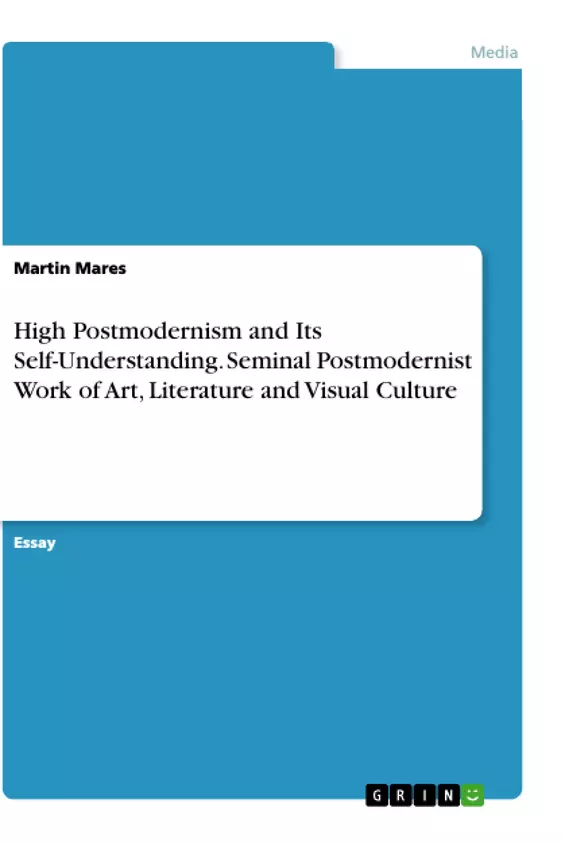This work attempts to examine the movement of Postmodernism in retrospective with a special emphasis on its signature elements such as the "metanaratives", the "hyperreality", the "simulacra and simulation" and additional attached motifs like feminism, post-colonialism, gender and racial equality. It seeks to introduce the reader to a core set of characteristics of postmodernism through a close interpretation of seminal works of art (for example Cindy Sherman, Andy Warhol), literature (for example Sonny's Blues, Recitatif) and cinema (for example Blade Runner) that have been considered as postmodernist.
Inhaltsverzeichnis (Table of Contents)
- Self-understanding of High Postmodernism
Zielsetzung und Themenschwerpunkte (Objectives and Key Themes)
This text aims to provide a critical overview of high postmodernism and its self-understanding through analysis of seminal postmodernist works of art, literature, and visual culture. It explores the key characteristics of postmodernism as identified by prominent theorists.
- The incredulity toward metanarratives and the rise of "petit narratives."
- The role of scientific progress and its commercialization in the postmodern condition.
- The concept of "hyperreality" and the simulacrum as a copy of a non-existing original.
- The manipulation of reality through mass media and its influence on society.
- The blurring lines between reality and simulation in a digital age.
Zusammenfassung der Kapitel (Chapter Summaries)
Self-understanding of High Postmodernism: This chapter delves into the core tenets of high postmodernism, primarily through the lens of Jean-François Lyotard's "The Postmodern Condition." Lyotard's concept of "incredulity toward metanarratives" is central, highlighting society's rejection of grand narratives in favor of fragmented, pluralistic "petit narratives." The chapter contrasts the pursuit of knowledge for its own sake with the commodification of knowledge in the digital age, arguing that these two approaches are irreconcilable within Lyotard's framework. Further, the chapter touches upon the role of scientific progress in delegitimizing obsolete ideologies and the challenges of legitimation in the context of coded information and rampant consumerism. Lyotard's proposed solution, "parology," or experimentation beyond established norms of reason, is introduced as a means to navigate these complexities. The chapter also introduces the conflict between scientific and narrative knowledge, emphasizing their use of different "language games."
Schlüsselwörter (Keywords)
High Postmodernism, Metanarratives, Petit Narratives, Jean-François Lyotard, The Postmodern Condition, Jean Baudrillard, Simulation and Simulacra, Hyperreality, Commodification of Knowledge, Digital Age, Consumerism, Mass Media, Language Games.
Frequently Asked Questions: A Comprehensive Language Preview of High Postmodernism
What is the main focus of this text?
This text provides a critical overview of high postmodernism and its self-understanding. It analyzes seminal works of art, literature, and visual culture to explore key postmodern characteristics as defined by prominent theorists.
What are the key themes explored in this text?
The text explores several key themes, including the incredulity toward metanarratives and the rise of "petit narratives"; the role of scientific progress and its commercialization; the concept of "hyperreality" and the simulacrum; the manipulation of reality through mass media; and the blurring lines between reality and simulation in the digital age.
Which theorists are discussed in this text?
The text centrally features the work of Jean-François Lyotard, particularly his concept of "incredulity toward metanarratives," as presented in "The Postmodern Condition." Jean Baudrillard's theories on simulation and simulacra are also referenced.
What is the significance of "metanarratives" and "petit narratives" in the text?
The text contrasts "metanarratives" (grand, overarching narratives) with "petit narratives" (fragmented, localized narratives). High postmodernism is characterized by a rejection of metanarratives in favor of the plurality of petit narratives.
How does the text address the relationship between science and postmodernism?
The text examines the role of scientific progress in delegitimizing older ideologies and the challenges of knowledge legitimation in a context of commodified knowledge and rampant consumerism. It highlights the conflict between scientific and narrative knowledge, emphasizing their different "language games."
What is the concept of "hyperreality" and its relevance?
The text explores "hyperreality," a concept related to simulacra, where simulations become more real than reality itself, and copies exist without originals. This concept is particularly relevant in discussions about the manipulation of reality through mass media and the digital age.
What is Lyotard's "parology," and what is its purpose?
Lyotard's "parology" is presented as a means to navigate the complexities of postmodernism. It involves experimentation beyond established norms of reason.
What are the key chapters covered in the text, and what are their main focuses?
The primary chapter discussed is "Self-understanding of High Postmodernism," which delves into the core tenets of high postmodernism, largely through Lyotard's lens. It analyzes the rejection of grand narratives, the commodification of knowledge, and the conflict between scientific and narrative knowledge.
What are the key words associated with the concepts discussed?
Key words include: High Postmodernism, Metanarratives, Petit Narratives, Jean-François Lyotard, The Postmodern Condition, Jean Baudrillard, Simulation and Simulacra, Hyperreality, Commodification of Knowledge, Digital Age, Consumerism, Mass Media, Language Games.
- Citation du texte
- Dr. Martin Mares (Auteur), 2017, High Postmodernism and Its Self-Understanding. Seminal Postmodernist Work of Art, Literature and Visual Culture, Munich, GRIN Verlag, https://www.grin.com/document/505059



